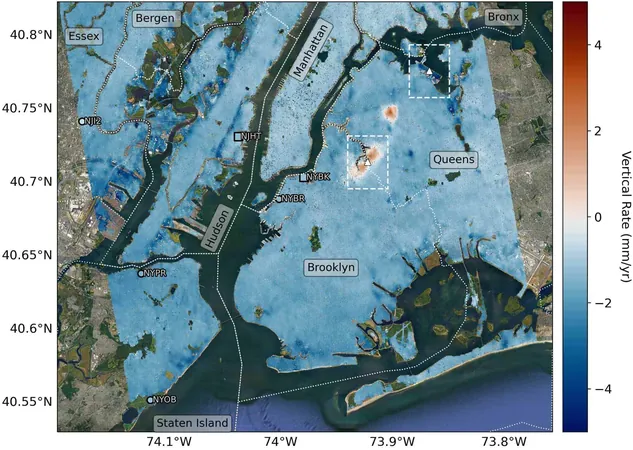
New York City Continues to Sink: A Deep Dive into the Urban Crisis
2025-09-15
Author: Sarah
The Sinking Suburbia of New York City
New York City is sinking—yes, you heard that right! Recent studies reveal that significant portions of the Big Apple are slowly descending at varying rates. Researchers first flagged this startling trend in 2023, positing that the immense weight of the city's skyscrapers could be a contributing factor. Fast forward to today, and evidence confirms that NYC's subsidence is ongoing, and the reasons are more complex than we imagined.
Hidden Forces at Play
Experts attribute New York's steady sinking to various factors, from ancient glaciers to modern land-use practices. While the annual decline may seem minimal—under 2 millimeters per year—the cumulative effect can dramatically affect local flood risks, especially as sea levels continue to rise.
Space Technology Uncovers Secrets
Employing state-of-the-art technology known as interferometric synthetic aperture radar (InSAR), scientists are mapping these subtle yet significant shifts in the landscape. This sophisticated satellite method analyzes radar signals bounced off the ground, allowing researchers to create detailed maps showing ground movement with millimeter-level accuracy.
The History Beneath Our Feet
A considerable portion of NYC’s sinking is linked to geological processes that date back to the last Ice Age. Around 24,000 years ago, a colossal ice sheet loomed over New England, and as it retreated, areas like New York City began a slow process of subsidence. Average subsidence in the metropolitan area is approximately 1.6 millimeters per year—similar to how fast toenails grow!
Sinking Hotspots Revealed
The studies have pinpointed alarming hotspots of subsidence. LaGuardia Airport's runway 13/31 is sinking at a startling rate of 3.7 millimeters per year, while Arthur Ashe Stadium—the venue for the US Open—faces an even steeper decline at 4.6 millimeters annually. Both sites are built on reclaimed land, making them particularly vulnerable to compression.
The Unexpected Rise
Interestingly, not all of New York is sinking! Certain areas, like East Williamsburg, are experiencing slight elevation increases, with land rising about 1.6 millimeters each year. This surprising trend adds a twist to the stark narrative of NYC's descent.
A Growing Crisis Across America
The challenges don’t stop in NYC. A 2025 study using satellite data has revealed that subsidence is a widespread issue threatening many major U.S. cities. Alarmingly, nearly all cities analyzed showed at least 20% of their urban landscapes sinking, with New York's affected land exceeding a shocking 98%!
Human Impact Matters
While natural factors like Glacial Isostatic Adjustment play a role, it's human activities—particularly groundwater extraction—that significantly exacerbate the subsidence crisis. Research indicates that cities facing intense groundwater withdrawal are the most susceptible to sinking, a reality that demands urgent attention.
A Call to Action
As the threat of infrastructure damage looms, with thousands of buildings in high-risk zones, policymakers and urban planners must urgently address the implications of this descent. The sinking crisis presents a slow-moving yet critical environmental challenge that requires immediate, strategic action.
Conclusion
In essence, as New York City continues its complex dance with gravity, it’s crucial for its inhabitants and leaders to take heed, adjusting their strategies for urban planning and resource management. The fate of America's cities depends on how we respond to this profound environmental challenge.





 Brasil (PT)
Brasil (PT)
 Canada (EN)
Canada (EN)
 Chile (ES)
Chile (ES)
 Česko (CS)
Česko (CS)
 대한민국 (KO)
대한민국 (KO)
 España (ES)
España (ES)
 France (FR)
France (FR)
 Hong Kong (EN)
Hong Kong (EN)
 Italia (IT)
Italia (IT)
 日本 (JA)
日本 (JA)
 Magyarország (HU)
Magyarország (HU)
 Norge (NO)
Norge (NO)
 Polska (PL)
Polska (PL)
 Schweiz (DE)
Schweiz (DE)
 Singapore (EN)
Singapore (EN)
 Sverige (SV)
Sverige (SV)
 Suomi (FI)
Suomi (FI)
 Türkiye (TR)
Türkiye (TR)
 الإمارات العربية المتحدة (AR)
الإمارات العربية المتحدة (AR)